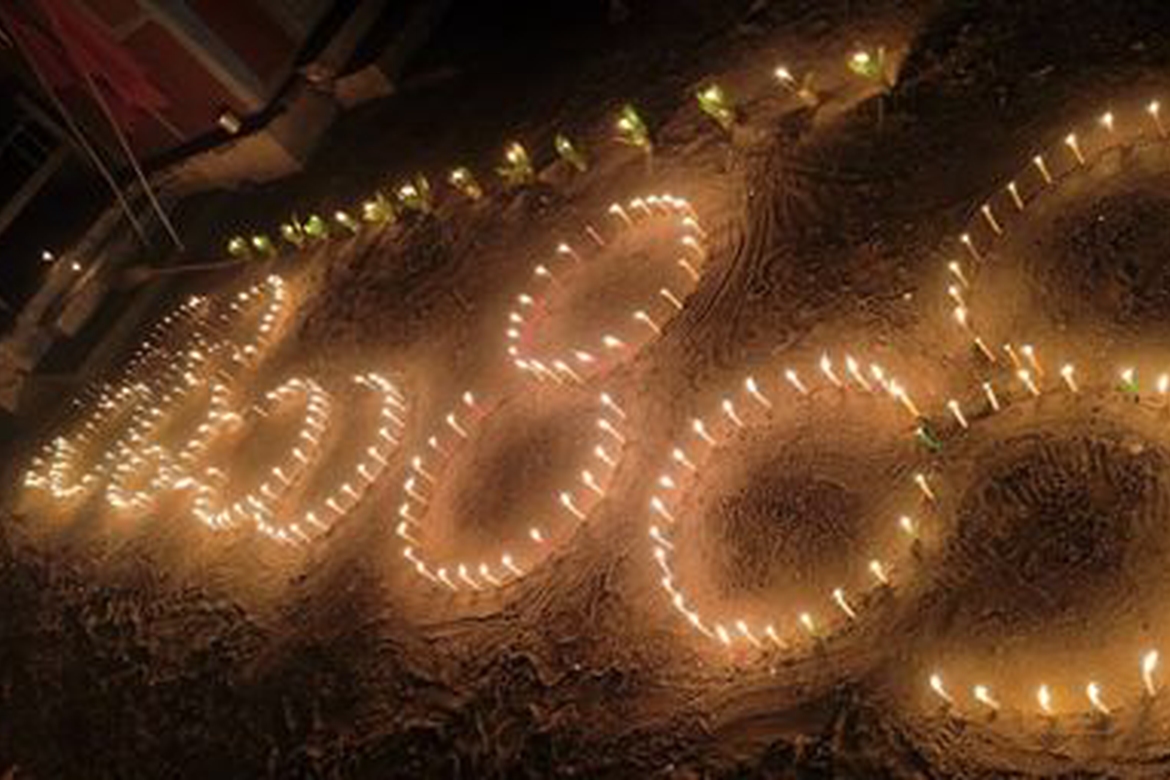More than 40 Buddhists were killed by their government during full moon festival in Myanmar
More than 40 people were killed and approximately 50 injured when military forces purposefully bombed civilian worshipers in Myanmar’s Sagaing region on Oct. 6.

A Buddhist light festival in the village Bone To was interrupted by a massacre on Oct. 6. The image shows a similar light wake in the village.
On Oct. 6, more than 40 people were killed and approximately 50 injured when military forces in Myanmar’s Sagaing region purposefully bombed civilian worshipers. That is according to Christian Solidarity Worldwide (CSW), a Stefanus Alliance sister organization.
Reports indicate that the military released explosives from a paramotor – a paraglider with an engine – over a crowd of approximately 300 civilians near the village Bone To in Chaung-U Township. They were celebrating the Thadingyut full moon festival, an important religious celebration for Buddhists. The celebration is said to have been combined with a silent protest against the regime.
The explosions from two 120 mm grenades immediately killed more than 40 people, and an additional 50 were seriously injured. The final death count is not yet confirmed. According to the first reports, several of those killed were children under the age of ten years old.
“The military junta will bomb anything that stands in its path in the fight for control of territory – even a peaceful Buddhist festival like this,” said a worried UN official we met in Bangkok this week, who wishes to remain nameless.
Survivors Describe Horror After Explosions
Among those killed are several teachers and students who participated in the Civil Disobedience Movement (CDM) against Myanmar’s military junta. Survivors describe seeing dismembered and mutilated bodies, and a horrible and traumatic aftermath.
Scot Bower, the chief executive officer of CSW, says “This brutal aerial assault on a peaceful vigil is a deliberate attack on the fundamental principles of freedom of religion or belief and basic human dignity. Myanmar’s military generals have taken advantage of the country’s ongoing political crisis to launch a campaign of terror against civilians and their beliefs. The horrific nature of the casualties cannot be ignored. We urge the international community and all governments to explicitly denounce the attack as a gross violation of the Freedom of Religion or Belief (FoRB) and a likely war crime aimed at cultural and civilian life, and to urge the Myanmar military to halt all air and artillery strikes on peaceful gatherings, religious observances and civilian regions without delay.”
Myanmar’s Long History of Military Control and Suppression
The military junta gets most of its power from the Bamar, formerly known as the Burmese, an ethnic group, who comprise Myanmar’s dominating ethnic majority. The majority of them are Buddhist.
The junta reclaimed power in a coup on February 1 2021 – a year after Aung San Suu Kyi and her supporters had won the election in November 2020. The brutal coup ended a decade of partial progress toward democratic development. The nation has been under various degrees of army control since gaining independence from Great Britain in 1948. In 1962, a military dictatorship was instituted, and a well-known large-scale crackdown on peaceful demonstrations occurred in 1988.
After the 2021 coup, peaceful demonstrations were violently struck down. Many protestors responded by taking up arms alongside military rebel groups that had already existed in multiple states along the borders to Bangladesh, India, and Thailand, each with their own ethnic minorities.
Unlike in previous uprisings, many Bamar people have since the coup in 2021 had their eyes opened to the brutality that, for decades, the military junta has shown minorities. A National Unity Government (NGU) was formed after numerous politicians and activists managed to flee in February 2021. In this assembly, many minority groups are represented.
Extremist Buddhist monks have encouraged the generals to brutality, for example among the primarily Muslim Rohingya minority, with 700,000 brutally displaced in 2017. Since the coup, many Buddhist monks have also participated in protests against the junta dictatorship.
A Scramble for Control
The armed rebel groups and the new people’s militias have, in facing a brutal junta, have gained ground in the last couple of years. At the beginning of 2025, the junta only had full control over less than a quarter of the country, while rebel groups fully controlled more than 40 percent of the territory.
This fall, the junta announced a new election in December – with very little promise of legitimacy.
“This will not be a legitimate election. It is a desperate junta that is bombing everything in its path to expand its control, and increase the number of areas where generals can conduct what they call elections,” the UN official in Bangkok warns.
“The world should not believe the results of this ‘election’,” the UN official told us. “Instead, the world must support the forces that wish to create a new Myanmar, based on human rights and the rule of law, for example in the Karen (Kayah) state on the border to Thailand.”